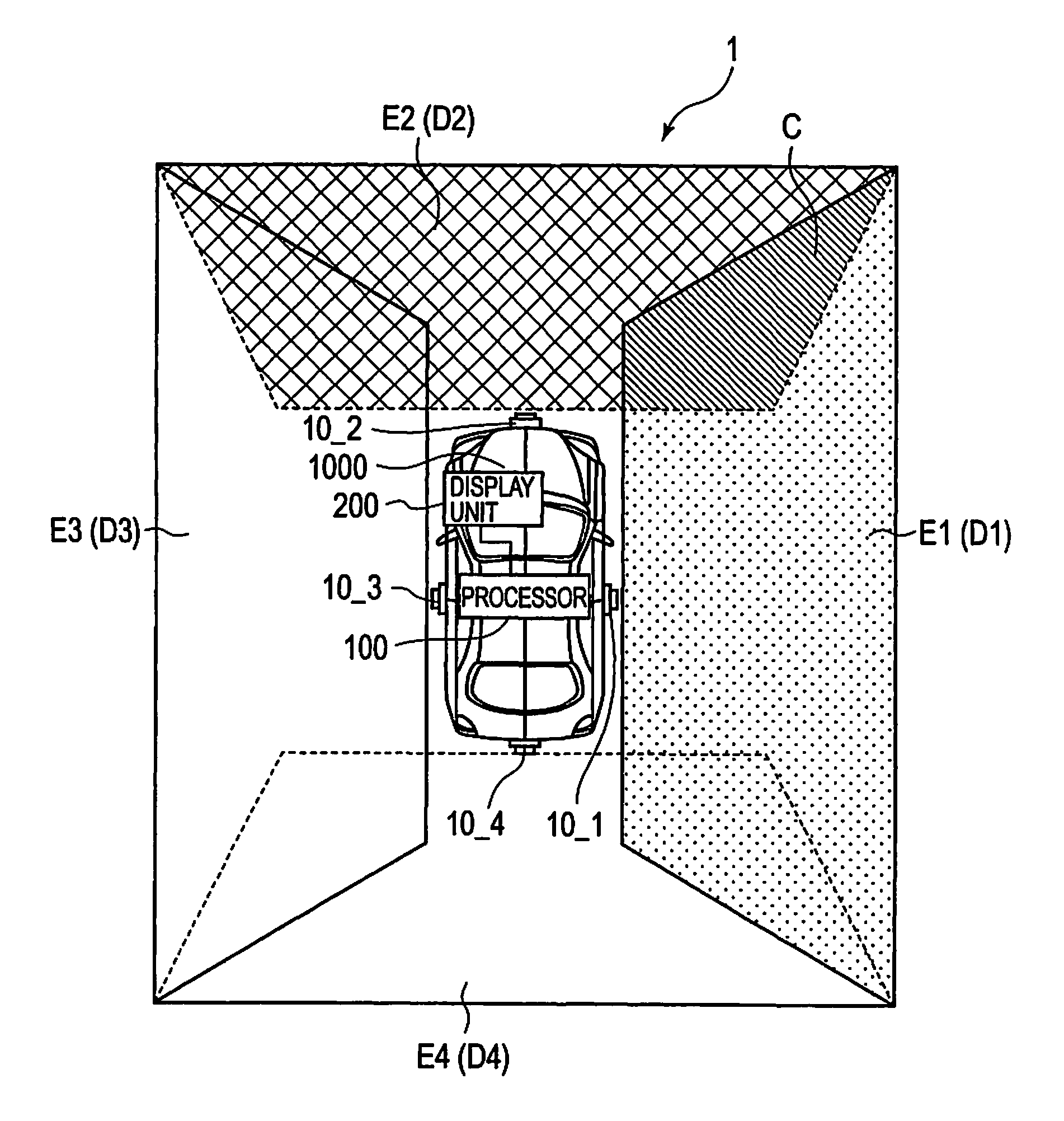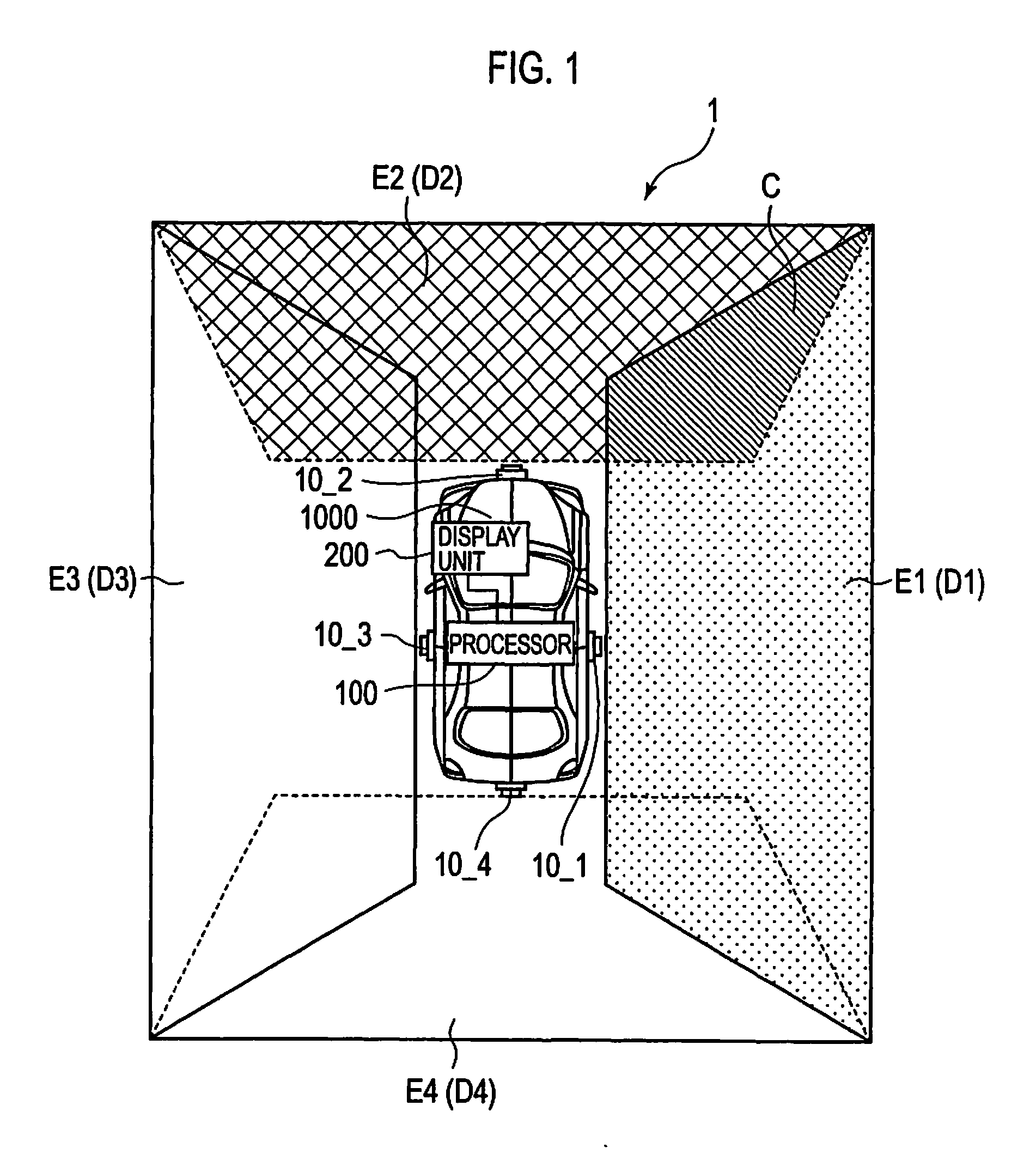Image processor, driving assistance system, and out-of-position detecting method
a technology of image processing and driving assistance, applied in the direction of image enhancement, television systems, instruments, etc., can solve the problems of insufficient driver generated image, inconvenient parameter values, and sometimes occurring differences in images, etc., to achieve accurate determination
- Summary
- Abstract
- Description
- Claims
- Application Information
AI Technical Summary
Benefits of technology
Problems solved by technology
Method used
Image
Examples
first embodiment
(Operation / Effect of Driving Assistance System of First Embodiment)
[0085]In driving assistance system 1 of the first embodiment, in processor 100, solid object determination unit 50 determines whether there is a solid object in an overlapping region within projection image E1, and when solid object determination unit 50 determines that there is no solid object, difference calculator 60 calculates a difference between an image corresponding to overlapping region C1 within projection image E1, and an image corresponding to overlapping region C2 within projection image E2.
[0086]That is, in processor 100, after confirming that there is no solid object in an image of overlapping region C, a difference between an image corresponding to overlapping region C1 within projection image E1, and an image corresponding to overlapping region C2 within projection image E2 is calculated. Therefore, driving assistance system 1 is capable of preventing the difference from being inaccurately calculated...
second embodiment
(Configuration of Driving Assistance System of Second Embodiment of Present Invention)
[0090]A second embodiment of the present invention will be described with particular attention focused on points different from the first embodiment. FIG. 7 is a block diagram showing processor 100 (an image processor) of this embodiment. As shown in FIG. 7, processor 100 further includes moving distance obtaining unit 80. Further, solid object determination unit 50 includes determination unit 53 and identifier 54.
[0091]While vehicle cameras 10_1 to 10_4 capture images periodically, moving distance obtaining unit 80 obtains a moving distance L of a vehicle between timing t1 (a first timing) and timing t2 (a second timing) coming after timing t1.
[0092]For example, moving distance obtaining unit 80 detects the number of rotations of a wheel in a period of timing t1 to timing t2. A moving distance L of a wheel is acquired based on the detected amount of rotations and an outer circumference stored in a...
third embodiment
(Configuration of Driving Assistance System of Third Embodiment of Present Invention)
[0106]A third embodiment of the present invention will be described with particular attention focused on points different from the first embodiment. FIG. 10 is a block diagram showing processor 100 (an image processor) of this embodiment. As shown in FIG. 10, processor 100 does not include solid object determination unit 50.
[0107]Further, difference calculator 60 of this embodiment calculates a difference between an image corresponding to overlapping region C1 within projection image E1, and an image corresponding to overlapping region C2 within projection image E2.
[0108]In addition, detector 70 of this embodiment detects that vehicle camera 10_1 or vehicle camera 10_2 has moved out of its proper position, based on the number of times that the difference calculated by difference calculator 60 consecutively takes a value not less than a threshold value.
[0109]To be more precise, detector 70 stores the...
PUM
 Login to View More
Login to View More Abstract
Description
Claims
Application Information
 Login to View More
Login to View More - R&D
- Intellectual Property
- Life Sciences
- Materials
- Tech Scout
- Unparalleled Data Quality
- Higher Quality Content
- 60% Fewer Hallucinations
Browse by: Latest US Patents, China's latest patents, Technical Efficacy Thesaurus, Application Domain, Technology Topic, Popular Technical Reports.
© 2025 PatSnap. All rights reserved.Legal|Privacy policy|Modern Slavery Act Transparency Statement|Sitemap|About US| Contact US: help@patsnap.com



